About a week ago, I was tinkering with a few external SCSI drives. These external drives are those that draw power from one of the ports in a computer, instead of a wall wart or a direct power plug. In the process, I was humbled to learn a couple of lessons in electronics (I’m a software guy).
A couple of them are enclosures that draw power from an ADB port that is available on the Apple IIgs and older Macintoshes. The ADB port can be used as a source for +5v. These enclosures house 2.5” SCSI drives that were normally used in older Apple laptops before they switched to using IDE drives. These drives just need +5v and do not need the additional +12v source that the bigger 3.5” drives need.
One of the 2.5” drives I used was a 1GB Microtech RoadRunner drive. It is a slim IDE drive bolted to a SCSI-IDE adapter resulting in the same form factor as a regular 2.5” drive. Kind of helpful to know, since those old 2.5” SCSI drives are getting harder to find.
My first humbling lesson is learning that using the wrong polarity will kill something. Both enclosures have a barrel attachment to the power line connecting to the ADB port. Connection looked the same, but the first one was center-positive. I tried using the same center-positive line in the other enclosure and poof! – the ADB port in my IIgs just… died. Keyboard and mouse stopped working, +5v source not coming out, and so on. I could have attempted to bring out my soldering stuff, but eventually (remember that I’m not a hardware guy), I ended up sourcing another IIgs motherboard from a fellow Apple enthusiast.
The next couple of SCSI enclosures I worked with were for 3.5” SCSI drives. As mentioned, 3.5” drives typically need +12v and +5v. These enclosures were meant to connect to the DB-19 drive connector at the back of the IIgs or a chained external diskette drive.
The former is a MicroNet Technology MP-20 with a 20MB SCSI drive. It has a power cable from a DB-19 plug to a 5-pin DIN connector. From tracing the lines and referencing the DB-19 pinouts, the 5-pin DIN connector has the following pinout:
- Pin 1: +5v
- Pin 2: Ground
- Pin 3: +12v
- Pin 4: NC
- Pin 5: NC
The latter was an NCS Pro 85C with an 80MB SCSI drive. These were both impressive and expensive back in the days. For some reason, I don’t have the power cable for this. The power cable was supposed to connect from the DB-19 port and into the 3-pin mini-DIN socket behind the enclosure.
Not having been humbled enough with my polarity fiasco, I proceeded to wire up my own cable for the drive. I had an extra DuoDisk cable that I cut up to get the DB-19 end, but was stumped on the mini-DIN connector.
My first attempt involved noticing that LocalTalk cables (the ones that run the network length, not the ones that attach to the serial port) have those connectors. After performing once more the ritual dance of sacrificing a very good piece of hardware to make something else, I found out that the LocalTalk cable only had two lines. Well, duh! Networking only needs two lines. The gods weren’t looking favorably at me that day.
Off I went to the local Goodwill thrift store looking for a power adapter that uses the 3-pin mini-DIN connector. Sure enough, I found one (I think it was for a Westell DSL modem). The source voltage(s) did not matter since I would be cutting the cable. I had to shave some plastic off the connector before it would snugly fit into the socket at the SCSI enclosure box.
That’s when I had my second humbling lesson. I followed the traces wrong and initially had +5v going into the +12v line, and vice versa. This killed two of my SCSI drives (including the original one inside the NCS Pro 85C) before I realized what was wrong. After switching the two lines, I finally got one of my other IIgs to boot off the external drive.
You can see in the pictures the two partitions I have in the new SCSI drive I placed inside the enclosure.

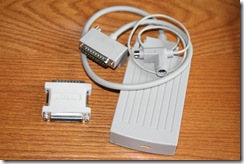
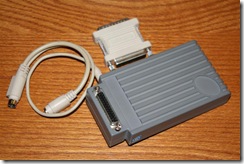
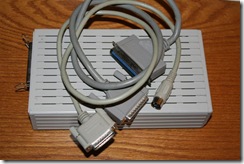
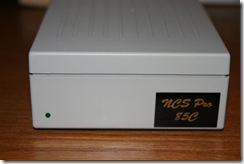
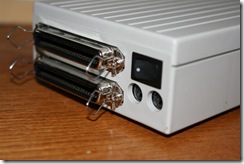
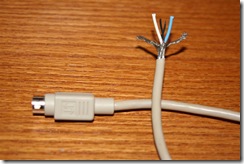
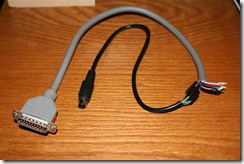
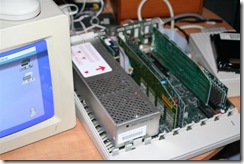
What would it take for you to make a duplicate of your NCS cable. I have a drive and no cable also…
@mike, Looking at the back of the NCS enclosure, at the 3-pin mini-DIN socket, the pinouts starting from the right going counter-clockwise would be: +5v, Ground, +12v. From the DuoDisk cable that I cut, I used Pin6 (blue wire) for +5v, Pin1 (olive wire) for Ground, and Pin7 (violet wire) for +12v.
The hardest part is really looking for the proper 3-pin mini-DIN plug, but I think they would be available in any online electronics store. DigiKey has these.
In the early 1990s I used a portable 2.5″-SCSI-drive like the darker gray (pictured second from top) quite frequently. At least on Mac LCs mine does not need the small power cable attached to an ADB port, as it was getting its juice from the SCSI-plug, which also serves as a mechanical mounting bracket. It was such a nice handy device, like a newer USB-drive, but about a decade earlier. At this time I had 3 jobs, with three similar Mac LCs on my three desks. The SCSI-drive was mounted directly at the back of the LCs, holding all my files and even a bootable system folder. It was moved from job to job, from Mac LC to Mac LC.
10 years later… still of relevance… happy mac user. 10′ 12′ mini… I have a Roland SP-700 circa 1992… SCSI is new to me weirdly enough but this sampler utilizes 2 SCSI links for it uploading n such… As well as my Akai S950 it has a r2-232a port same pin count as the SCSI and it loads its data from a floppy drive. The R port is option for control or MIDI. Also in my arsenal of the 90’s the golden era of everything really… Is a IBM thinkpad with the portable dock and stationary dock which is basically new still in is box strapped etc… IBM is running XP with a whopping 320mb of ram… the time we use to have then… so little was needed… and a JAZ drive…. Where would one find the best to the point resources and one of these tiny drives. The form factor and capacity is perfect. Ive never actually used the serial and parallel ports… briefly in elementary for printer reasons…. I also have a Layla Audio interface with a Serial to host…. Its said to require a PCI card but im curious wouldn’t a serial port suffice? All the card does is process the audio…